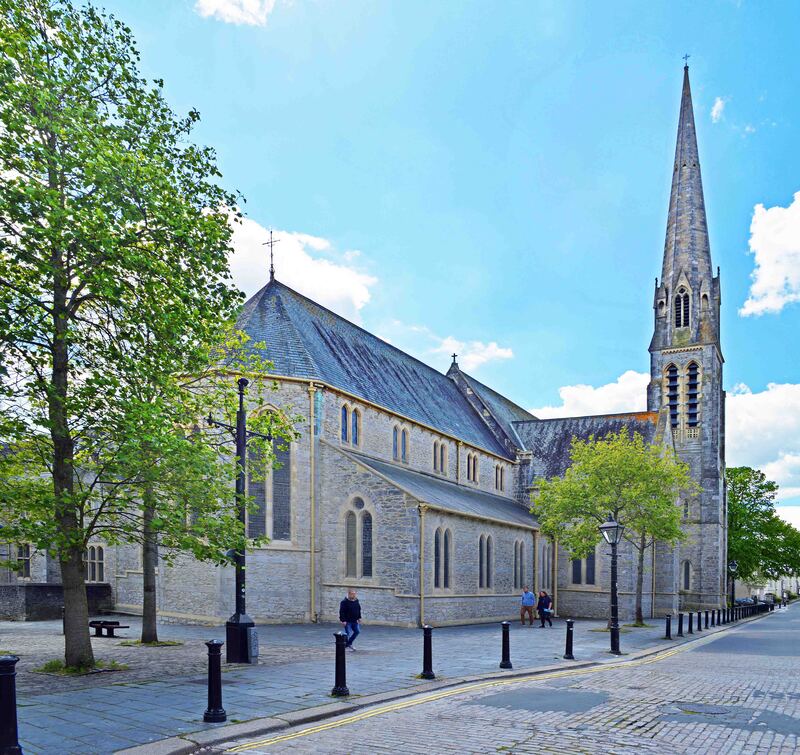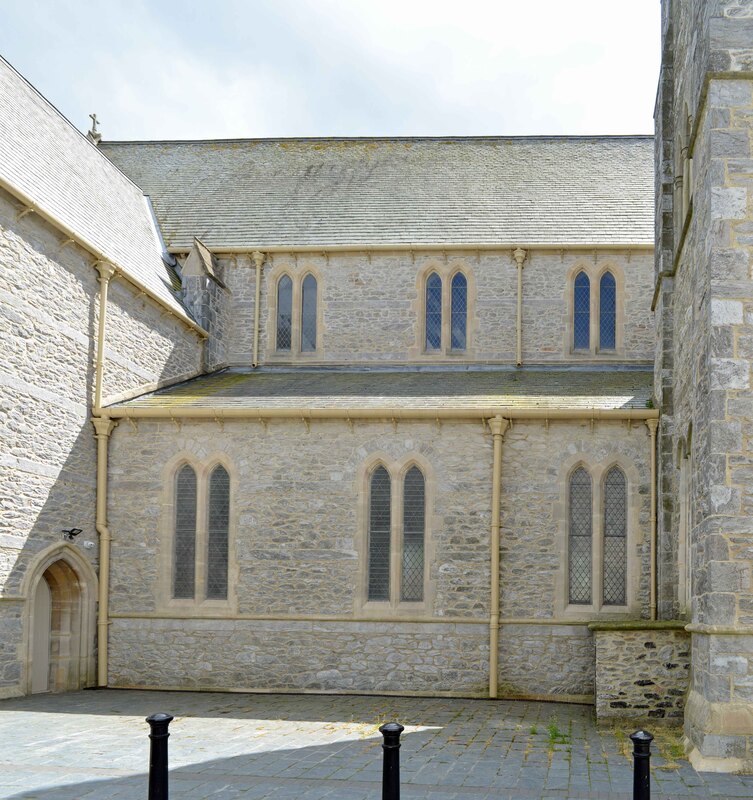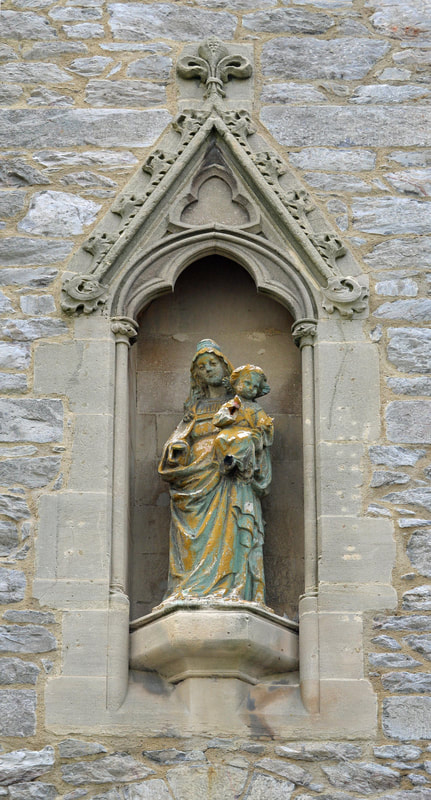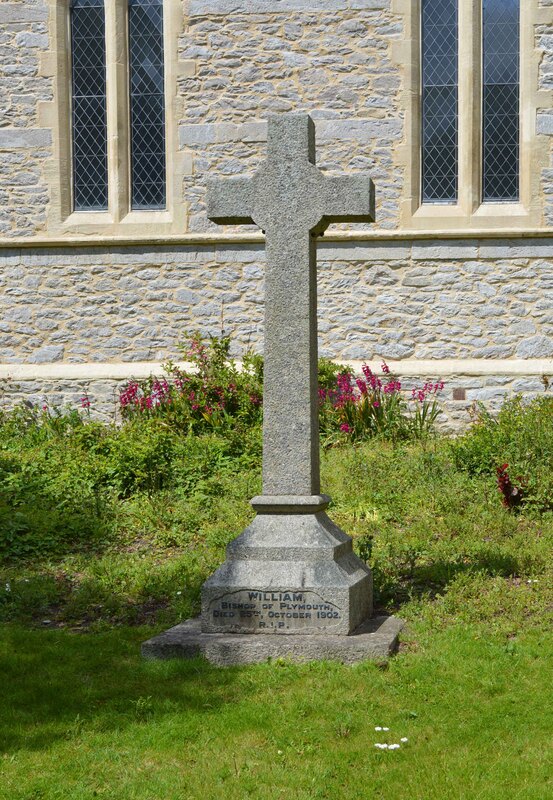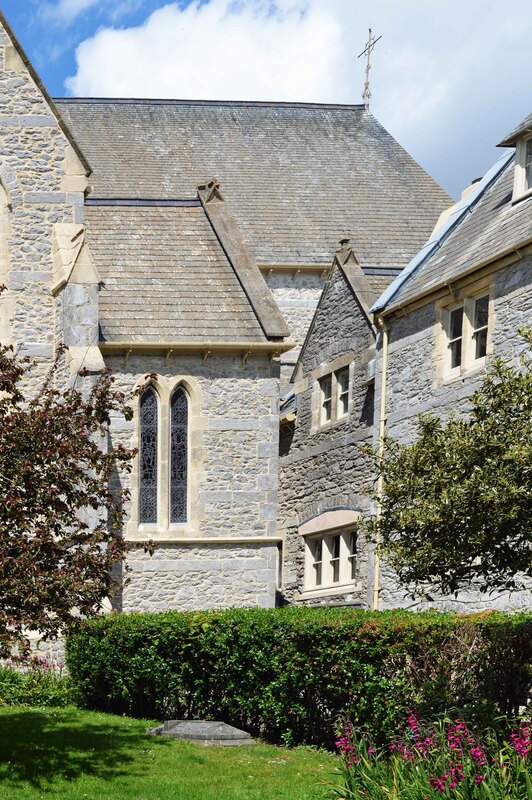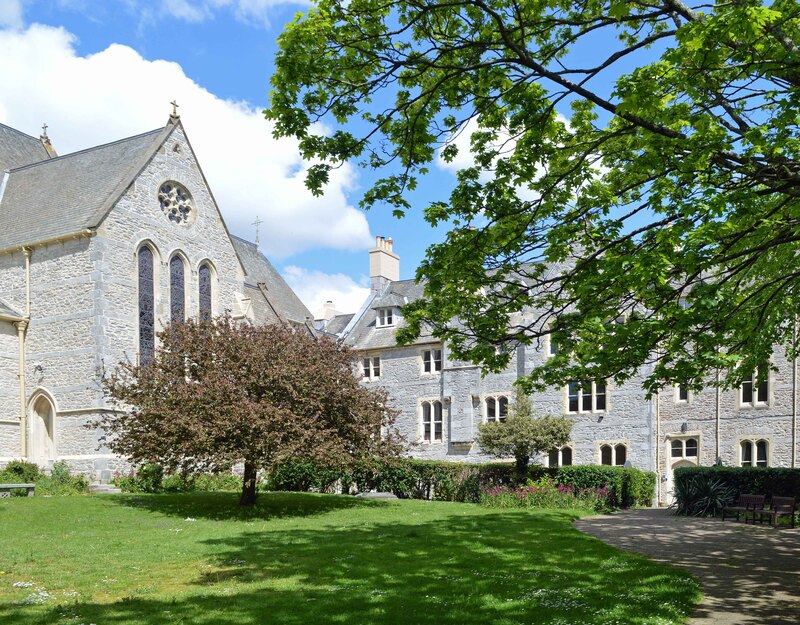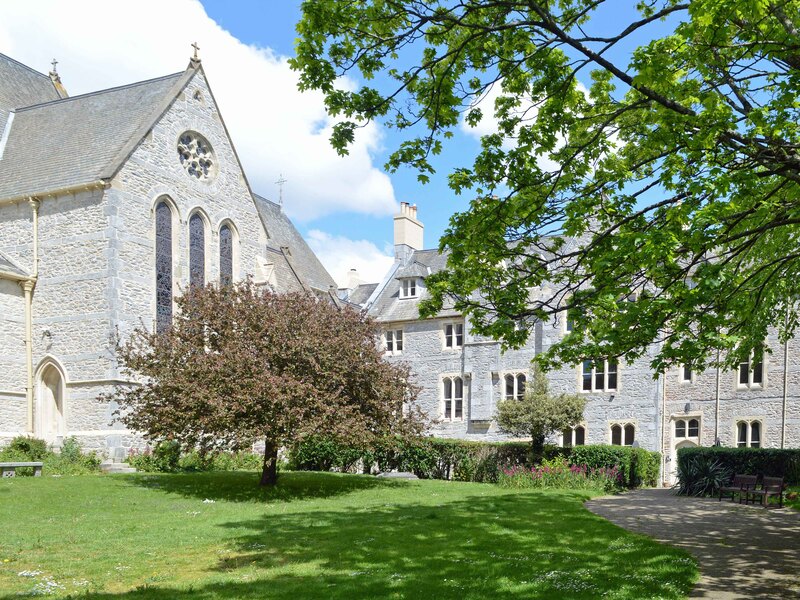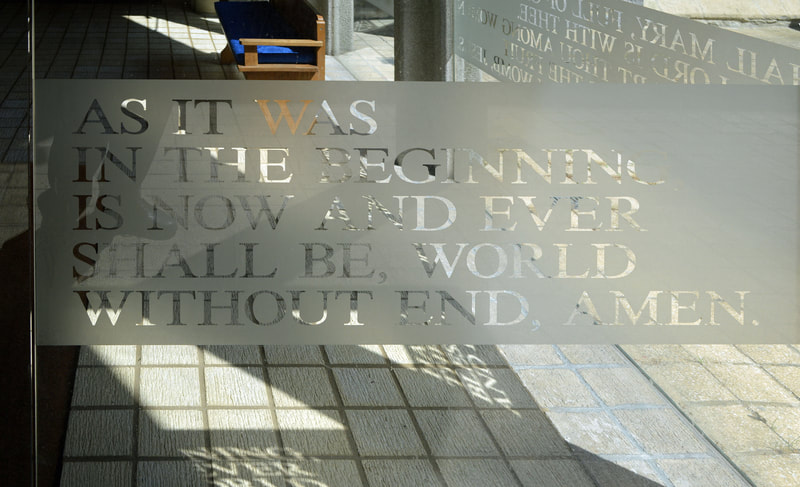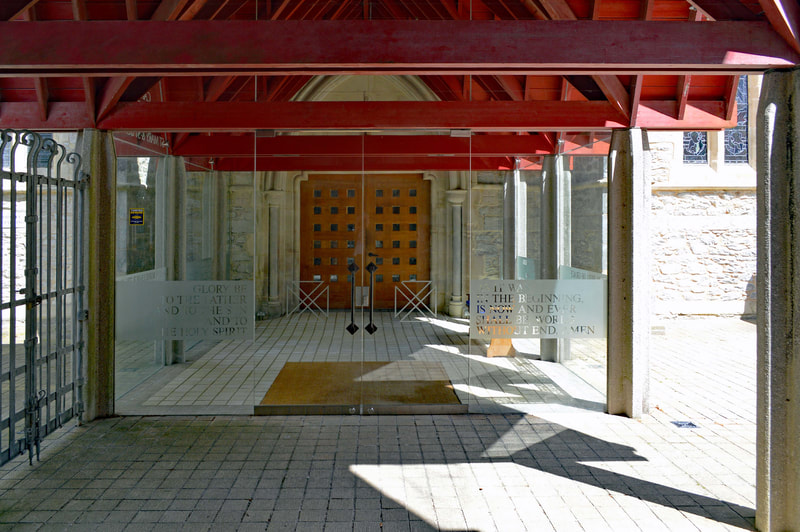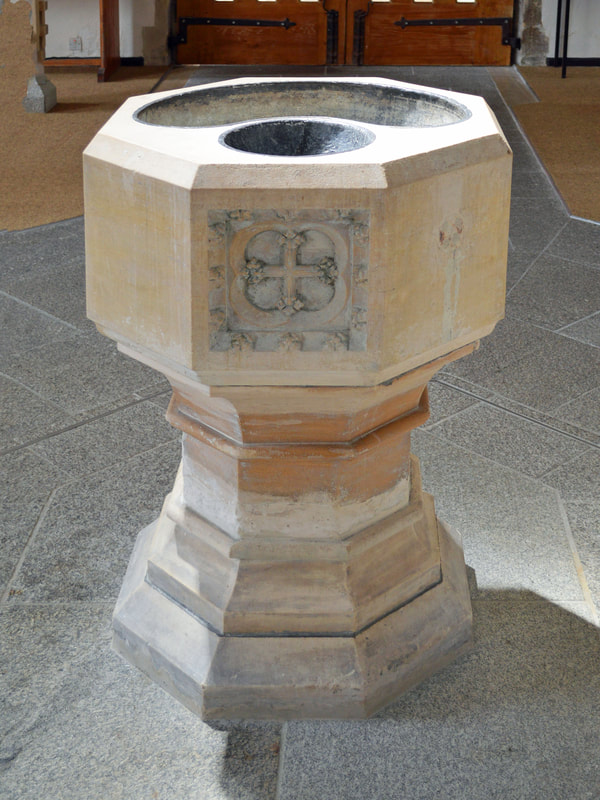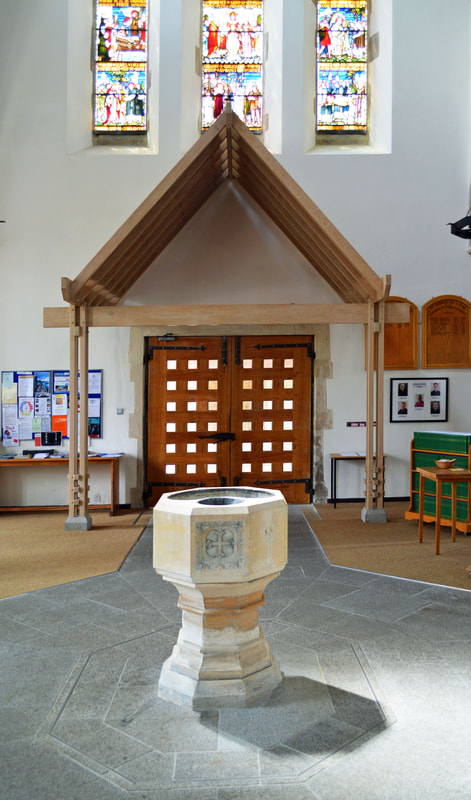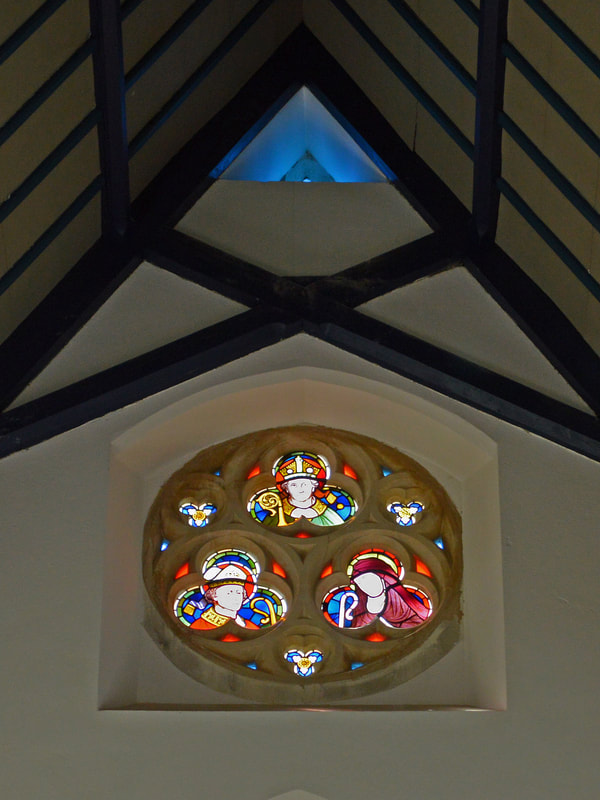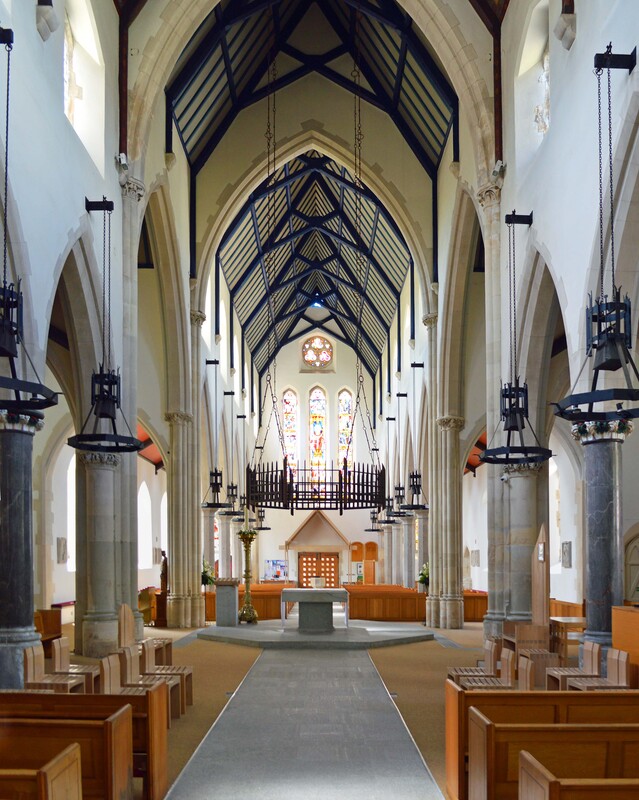Pictures courtesy of Paul Scott. To view a larger image please click on the thumbnails.
The East Wall
There is an apse with three windows at the East end of the Cathedral, and a small chapel on either side. The lower roof line along the North wall covers a chapel and the North ambulatory. We shall find that the gabled addition on this side of the North transept in fact houses the Cathedral organ.
There is an apse with three windows at the East end of the Cathedral, and a small chapel on either side. The lower roof line along the North wall covers a chapel and the North ambulatory. We shall find that the gabled addition on this side of the North transept in fact houses the Cathedral organ.
The North Chancel and Transept
We walk along the length of the Cathedral. The young trees and paved pedestrian way make this a pleasant area. The North transept has the same bold, uncluttered styling. It has three lancet windows, and a curious added buttress on the far Eastern corner. West of the transept we follow along the North nave wall. The central nave is lit by high clerestory windows, and the nearer aisle by larger pairs of lancets. The flow of the building is now interrupted by the base of the tower. The small door into the transept at left is used for entry to the Cathedral when the main doors are closed. It leads through to the Sacred Heart Chapel.
We walk along the length of the Cathedral. The young trees and paved pedestrian way make this a pleasant area. The North transept has the same bold, uncluttered styling. It has three lancet windows, and a curious added buttress on the far Eastern corner. West of the transept we follow along the North nave wall. The central nave is lit by high clerestory windows, and the nearer aisle by larger pairs of lancets. The flow of the building is now interrupted by the base of the tower. The small door into the transept at left is used for entry to the Cathedral when the main doors are closed. It leads through to the Sacred Heart Chapel.
The Alcove and West Face
Closer inspection reveals that ths alcove figure is the Virgin and Child, but in a severely weathered state. The little sheltering gable is nicely decorated and topped with a fleur-de-lys. There is a surprise at the West end of the Cathedral. An expanse of paving separates the Cathedral from the adjacent Diocesan Administrative Office, and the two buildings are connected by a stylish covered walkway.
Closer inspection reveals that ths alcove figure is the Virgin and Child, but in a severely weathered state. The little sheltering gable is nicely decorated and topped with a fleur-de-lys. There is a surprise at the West end of the Cathedral. An expanse of paving separates the Cathedral from the adjacent Diocesan Administrative Office, and the two buildings are connected by a stylish covered walkway.
The Bishop's Garden, Statue and Cross
On the South side is a large grassed area known as ‘The Bishop’s garden’. There are good views of the Cathedral from here. The East side of the Garden is bounded by the old St Mary’s School, which has now been converted into residential apartments. This building on Cecil Street abuts the Cathedral sanctuary in a mysterious way! There is a memorial cross in the Garden near the wall of the Cathedral. The inscription on the base of the cross reads: ‘William, Bishop of Plymouth, Died 25th October 1902. R.I.P.’ William Joseph Vaughan (14 February 1814- 25 October 1902) was a British clergyman who held high office in the Roman Catholic Church as the second bishop of Plymouth. He was born on 14 February 1814 in London, England, the second son of William Vaughan, of an old recusant (dissenting Roman Catholic) family, the Vaughans of Courtfield, Herefordshire. Near the entry to the Garden is this statue of ‘Our Lady of Lourdes’. The inscription on the base reads: ‘Of your charity, pray for the soul of John Keily, Fourth Bishop of Plymouth, Born 23rd June 1854, Ordained Priest 18th March 1877, Consecrated Bishop 13th June 1911, Died 23rd September 1928. Fortified by the Rites of the Church, May he rest in peace. Our Lady of Lourdes pray for him.’
On the South side is a large grassed area known as ‘The Bishop’s garden’. There are good views of the Cathedral from here. The East side of the Garden is bounded by the old St Mary’s School, which has now been converted into residential apartments. This building on Cecil Street abuts the Cathedral sanctuary in a mysterious way! There is a memorial cross in the Garden near the wall of the Cathedral. The inscription on the base of the cross reads: ‘William, Bishop of Plymouth, Died 25th October 1902. R.I.P.’ William Joseph Vaughan (14 February 1814- 25 October 1902) was a British clergyman who held high office in the Roman Catholic Church as the second bishop of Plymouth. He was born on 14 February 1814 in London, England, the second son of William Vaughan, of an old recusant (dissenting Roman Catholic) family, the Vaughans of Courtfield, Herefordshire. Near the entry to the Garden is this statue of ‘Our Lady of Lourdes’. The inscription on the base reads: ‘Of your charity, pray for the soul of John Keily, Fourth Bishop of Plymouth, Born 23rd June 1854, Ordained Priest 18th March 1877, Consecrated Bishop 13th June 1911, Died 23rd September 1928. Fortified by the Rites of the Church, May he rest in peace. Our Lady of Lourdes pray for him.’
The West Narthex North and South Wall
We return back up to the walkway as we prepare to enter the Cathedral. The glass sides of the walkway closest to the Cathedral are inscribed with text, as are the glass doors where we enter. We shall call this glass porch the Cathedral narthex. The words on the North wall are those of The Lord’s Prayer: Our Father who art in heaven, Hallowed be thy Name. Thy kingdom come, thy will be done on earth as it is in heaven. Give us this day our daily bread and forgive us our trespassers, as we forgive those who trespass against us, and lead us not into temptation bur deliver us from evil. Amen. The text on the South wall reads: ’Hail Mary, full of grace, The Lord is with thee. Blessed art thou amongst women, and blessed is the fruit of thy womb, Jesus. Holy Mary, Mother of God, pray for us sinners now and at the hour of our death. Amen.‘
We return back up to the walkway as we prepare to enter the Cathedral. The glass sides of the walkway closest to the Cathedral are inscribed with text, as are the glass doors where we enter. We shall call this glass porch the Cathedral narthex. The words on the North wall are those of The Lord’s Prayer: Our Father who art in heaven, Hallowed be thy Name. Thy kingdom come, thy will be done on earth as it is in heaven. Give us this day our daily bread and forgive us our trespassers, as we forgive those who trespass against us, and lead us not into temptation bur deliver us from evil. Amen. The text on the South wall reads: ’Hail Mary, full of grace, The Lord is with thee. Blessed art thou amongst women, and blessed is the fruit of thy womb, Jesus. Holy Mary, Mother of God, pray for us sinners now and at the hour of our death. Amen.‘
Approaching the West Door
Now standing on the walkway and looking towards the Cathedral, we have to pass through a pair of glass doors on which are inscribed The Grace. The text reads: ‘Glory be to the Father, and to the Son, and to the Holy Spirit, as it was in the beginning, is now and ever shall be, world without end, Amen. Above the actual Cathedral doors, affixed to the gable, is a small crucifix: the crucified Christ looking down on worshippers as they enter the Cathedral.
Now standing on the walkway and looking towards the Cathedral, we have to pass through a pair of glass doors on which are inscribed The Grace. The text reads: ‘Glory be to the Father, and to the Son, and to the Holy Spirit, as it was in the beginning, is now and ever shall be, world without end, Amen. Above the actual Cathedral doors, affixed to the gable, is a small crucifix: the crucified Christ looking down on worshippers as they enter the Cathedral.
West Rose Window, West Window and Nave Side West Windows
The detail of this window is poor at this distance, and I have trouble interpreting the window as well. Three trefoil figures: a king (St Boniface?), a young prince and a nun – all involved in pastoral care as indicated by the staffs.
The West window contains a number of small subtitled scenes from the life of St Winifred Boniface. Boniface is celebrated (and criticized) as a missionary; he is regarded as a unifier of Europe, and he is seen (mainly by Catholics) as a Germanic national figure. In 2019 Devon County Council with the support of the Anglican and Catholic churches in Exeter and Plymouth, officially recognised St Boniface as the Patron Saint of Devon.
Pictured here are the two side windows in the West wall. The window at left shows Jesus being baptised by John the Baptist (‘Behold the Lamb of God.’) The window at right shows two saints: St Francis of Assisi, and St Francis de Sales. Francis de Sales was a Bishop of Geneva and is honored as a saint in the Catholic Church. He became noted for his deep faith and his gentle approach to the religious divisions in his land resulting from the Protestant Reformation.
The detail of this window is poor at this distance, and I have trouble interpreting the window as well. Three trefoil figures: a king (St Boniface?), a young prince and a nun – all involved in pastoral care as indicated by the staffs.
The West window contains a number of small subtitled scenes from the life of St Winifred Boniface. Boniface is celebrated (and criticized) as a missionary; he is regarded as a unifier of Europe, and he is seen (mainly by Catholics) as a Germanic national figure. In 2019 Devon County Council with the support of the Anglican and Catholic churches in Exeter and Plymouth, officially recognised St Boniface as the Patron Saint of Devon.
Pictured here are the two side windows in the West wall. The window at left shows Jesus being baptised by John the Baptist (‘Behold the Lamb of God.’) The window at right shows two saints: St Francis of Assisi, and St Francis de Sales. Francis de Sales was a Bishop of Geneva and is honored as a saint in the Catholic Church. He became noted for his deep faith and his gentle approach to the religious divisions in his land resulting from the Protestant Reformation.
The Virgin and Child
The pews in the South transept all face East, and on the Easterly side is this statue of the Virgin and Child. A vase stands by the statue, with a beautiful white lily. The pedestal has text reading: ‘Pray for the soul of the Right Reverend John Keily, D.D. Fourth Bishop of Plymouth who died 23rd September 1928. R.I.P.’ I suspect that this transept serves as the Lady Chapel for this Cathedral.
The pews in the South transept all face East, and on the Easterly side is this statue of the Virgin and Child. A vase stands by the statue, with a beautiful white lily. The pedestal has text reading: ‘Pray for the soul of the Right Reverend John Keily, D.D. Fourth Bishop of Plymouth who died 23rd September 1928. R.I.P.’ I suspect that this transept serves as the Lady Chapel for this Cathedral.
Nave, West Nave and Looking West
Entering the Cathedral, the nave is before us. Slender columns supporting two rows of Gothic arches, striking orange ceilings over the side aisles, solid hanging candelabras for light, clear glass in the side windows and in the high clerestory windows above. Immediately before us the baptismal font, and the nave altar in the distance. Simple stations of the cross separate the side windows. This is a pleasing Cathedral: clear and uncluttered.
If we walk down the central nave aisle a little way and turn around, we can appreciate the West wall of the nave. The angled arch above the West doors continues the theme of the exterior walkway. Above us, the nave roof is picked out in simple black lines with a cute little blue triangle at the end. Then there are the windows: three lancets and a rose in the centre, and a smaller window on either side.
We finish our tour of this Cathedral by looking back along its length. The dark timbers of corona, chandeliers and roof contrast stunningly against the white walls and columns.
Entering the Cathedral, the nave is before us. Slender columns supporting two rows of Gothic arches, striking orange ceilings over the side aisles, solid hanging candelabras for light, clear glass in the side windows and in the high clerestory windows above. Immediately before us the baptismal font, and the nave altar in the distance. Simple stations of the cross separate the side windows. This is a pleasing Cathedral: clear and uncluttered.
If we walk down the central nave aisle a little way and turn around, we can appreciate the West wall of the nave. The angled arch above the West doors continues the theme of the exterior walkway. Above us, the nave roof is picked out in simple black lines with a cute little blue triangle at the end. Then there are the windows: three lancets and a rose in the centre, and a smaller window on either side.
We finish our tour of this Cathedral by looking back along its length. The dark timbers of corona, chandeliers and roof contrast stunningly against the white walls and columns.
Quick Links
